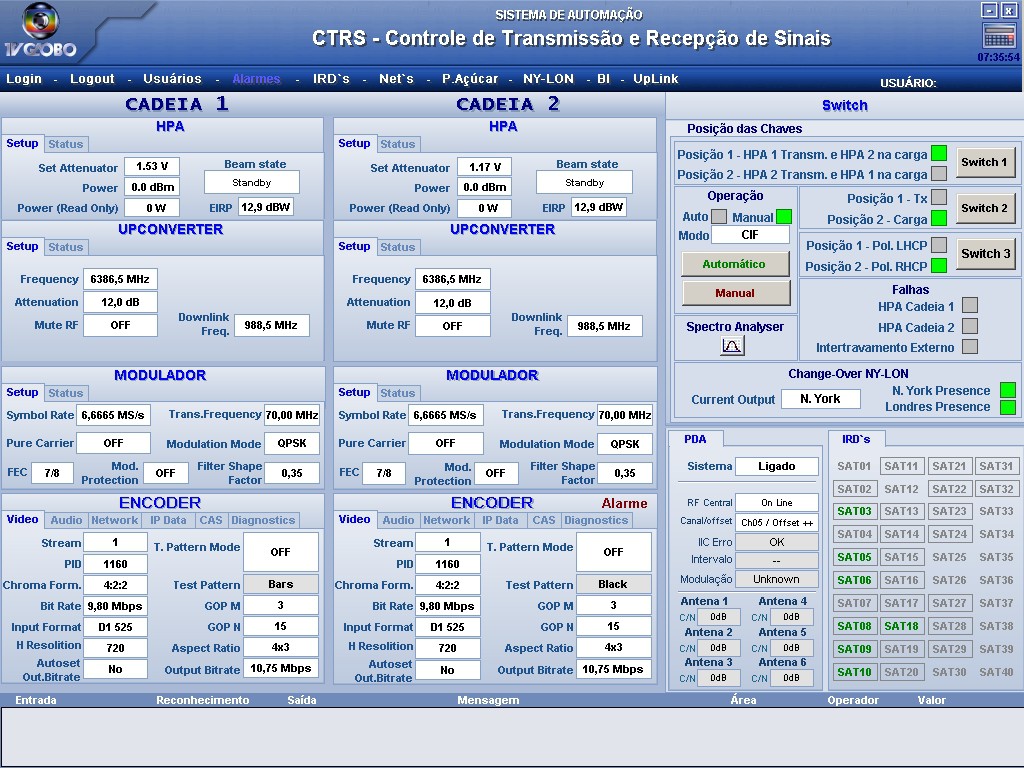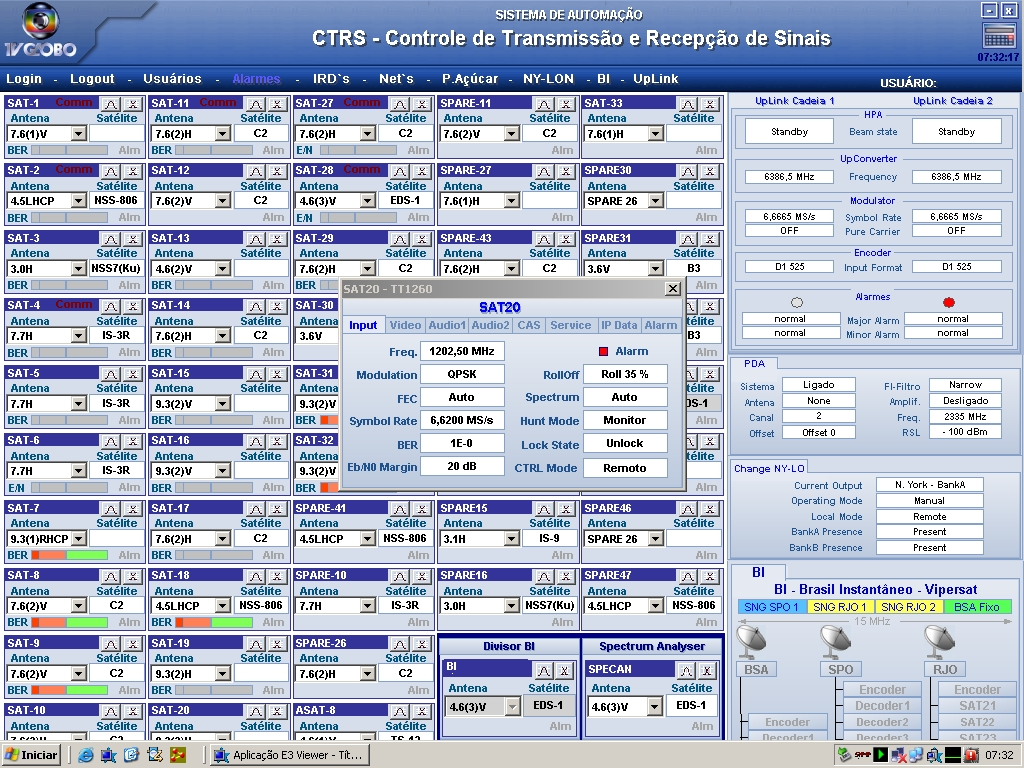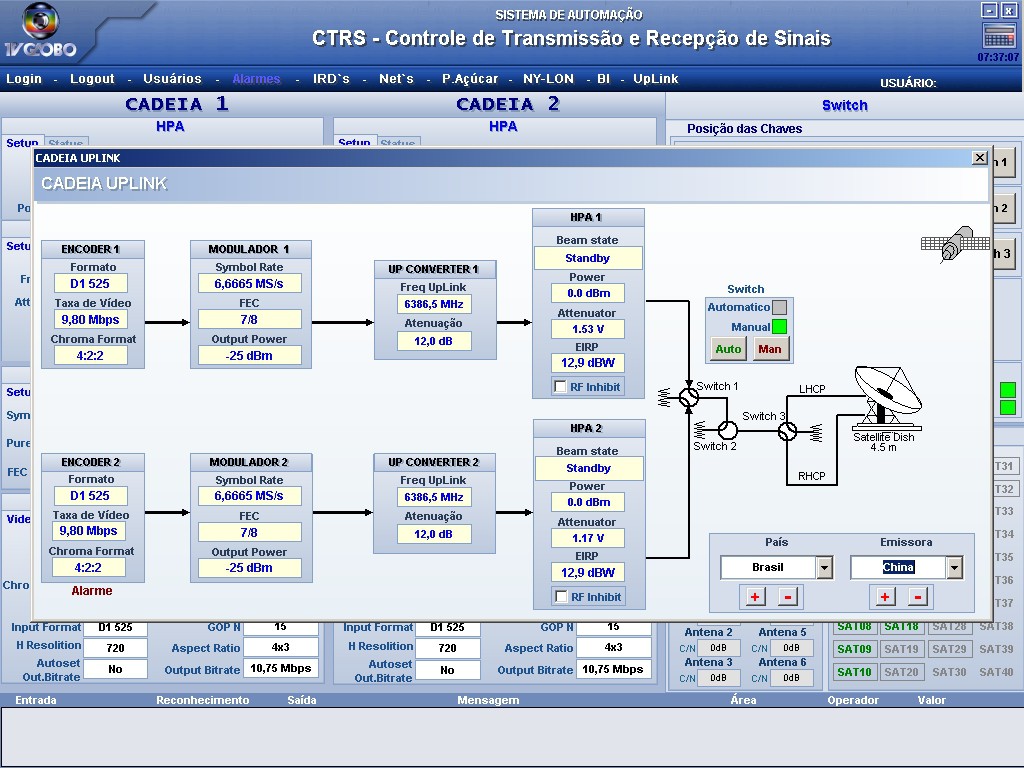Elipse E3 application at TV Globo’s Signal Reception Technical Center
In order to optimize their operation of signal reception in Rio de Janeiro’s office, TV Globo has chosen to implement E3, Elipse Software’s solution for supervision and control of processes

Needs
One of the world’s greatest television networks, and the indisputable leader in Brazilian ratings, TV Globo covers 98.4% of Brazil’s territory, reaching as many as 5564 cities, or 99.5% of the country’s population. An average of 90% of their programming is produced within the company, which makes TV Globo responsible for the employment of a great number of artists, writers, journalists, producers, and technicians.
Until 2008, more than 300 telenovelas and miniseries had been both produced and broadcasted by this channel. With their 11 international correspondents and 600 journalistic crews around the country, at least 80% of Brazilians get their news from TV Globo’s five daily hours of news programs.
In order to optimize their operation of signal reception in Rio de Janeiro’s office, TV Globo has chosen to implement E3, Elipse Software’s solution for supervision and control of processes. In this project, the direct participation of Eduardo Limoeiro, the manager of automation systems of ADKL Zeller Eletro Sistemas Ltda. (the systems integrator responsible for its development), was vital.
Altogether, there are six copies of E3 being used in this office’s Signal Reception Technical Center (SRTC): a Server, a Hot-Standby, and four Viewers.
Solution
To better understand all the advantages brought to TV Globo’s operation by this new tool, you must first understand how the SRTC operates. Located on the second floor of the journalism building, the SRTC comprises two different environments: the “Technical Center”, where the equipment for signal transmission and reception is, and the “Preview Room”, where the team in control of the operation is.
Before E3, whenever the equipment needed to be programmed to either receive or transmit a certain signal, the operators needed to go in person from the Preview Room to the Tech Center to perform this action manually. Their absence meant leaving the Preview Room unattended, which in turn meant leaving their internal clients unattended.
To change this reality, two computers running E3 now make it possible to control the whole process from the Preview Room. Thus, except for some extreme cases, such as having to handle manually some piece of equipment that does not respond to commands, for example, the frequency of operators’ visits to the Preview Room is expected to decrease. To solve this kind of problems, a third computer, running E3 Viewer, was installed in the Tech Center.
“With the Viewer, there is no need to return to the Preview Room to check if the signal was received after a technical glitch had been detected: this can be done here, without ever having to leave the equipment”, says Fernando Wiktor, TV Globo’s operational manager.
With this software, it is also possible to monitor the intensity with which the signal is received at the SRTC, and evaluate whether it can be used in the transmission. For the engineer of telecommunications projects in TV Globo Rio, Luis Fernando de Oliveira Loureiro, E3’s legible, user-friendly screens are features that stand out.
“The software displays a well-organized interface, with objects that make the process’ comprehension easier”, he says.
Finally, E3 has helped automate the reception of journalism signals sent by their offices in London (UK) and New York (US), bringing more quality and productivity to the SRTC.
“Without E3, none of this would have been possible. It was pivotal for our project”, says Loureiro.
Pleased with this solution, TV Globo Rio, alongside Elipse Software and ADKL, is now working on the implementation of a new functionality.
“The idea is to have E3 automate the signals generated by the mobile units. So, it will be possible for field crews to focus on a high-quality gathering of journalistic information. This will all be controlled by the computers in the Preview Room”, says the engineer.
Benefits
- Control of equipment receiving and transmitting signals is centralized in only one place.
- Signals transmission and reception process are automated, thus reducing the number of visits from the Preview Room to the Tech Center, and vice-versa.
- Decreased risks of breaking or losing signals.
- More agility when receiving or transmitting signals.
- Clear, legible interface, making system operation easier.
- Reception of signals generated in offices in London (UK) and New York (US) is automated.
Final Considerations
For the engineer Luis Fernando de Oliveira Loureiro, the arrival of E3 represents a new era towards automation and centralization of the system’s operation.
“With E3, we now have remote access to almost 90% of the equipment responsible for the reception and transmission of external signals, which makes signal monitoring more agile. So, not only does the software allow us to diagnose problems faster, but it also helps us fix them”, says the engineer.
Loureiro adds: “We have indubitably profited from this software. It has made setting up the system, reading the equipment, and finding solutions for different kinds of problems so much faster. With E3, we can interact with the equipment automatically, whether the communication is via satellite, microwaves, or optic fiber, in an agile, safe way. Now, we know that once a command was issued, it will be executed very quickly”.
Datasheet
Client: Globo Comunicação e Participações S.A.
Systems Integrator: ADKL ZELLER ELETRO SISTEMAS LTDA
Software: Elipse E3 2.5
Number of copies: 1
Platform: Windows XP
Number of I/O points: 10000
I/O driver: ASCII, Modbus Ethernet, RS-232 and OPC-SNMP


